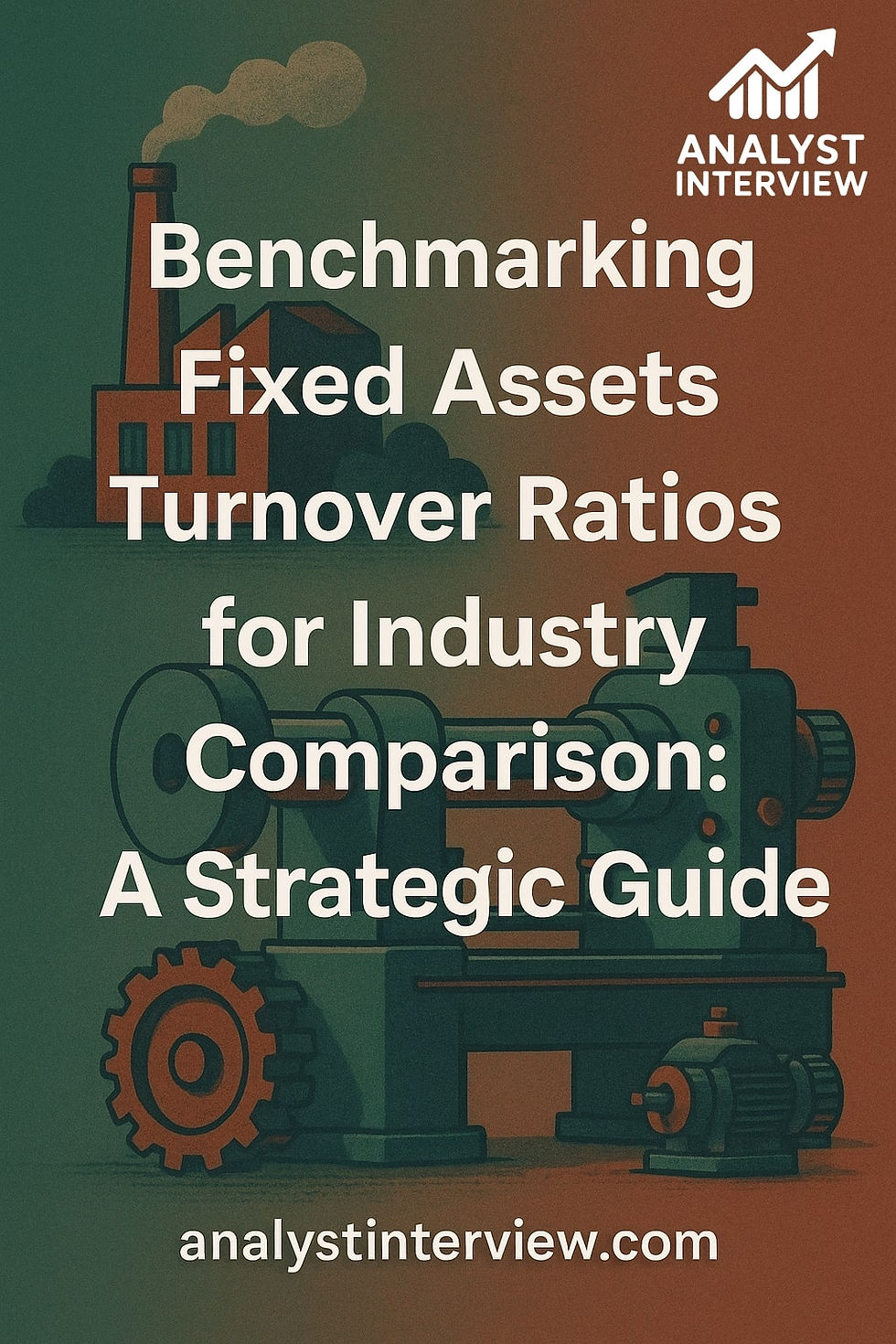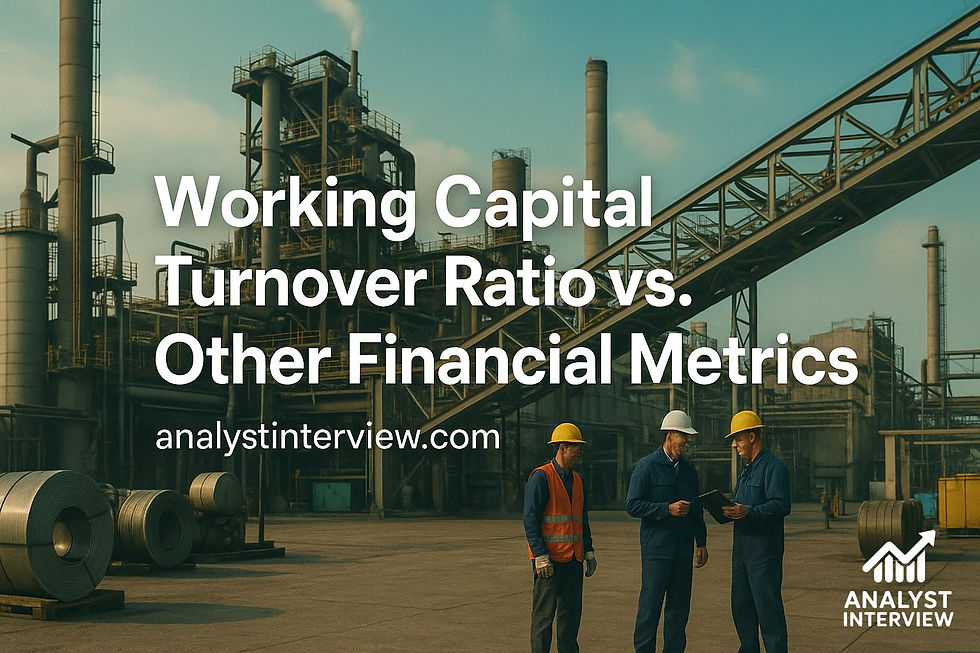Benchmarking Fixed Assets Turnover Ratios for Industry Comparison: A Strategic Guide
- Analyst Interview

- Jul 26
- 5 min read

What is the Fixed Assets Turnover Ratio?
The Fixed Assets Turnover Ratio shows how well a company squeezes sales from its fixed assets. The math is simple:
FATR = Net Sales / Average Net Fixed AssetsHere's what goes into it:
Net Sales: Revenue from your core business operations
Average Net Fixed Assets: The average value of your property, plants, and equipment after depreciation (usually the average between start and end of period)
A high FATR means you're getting more bang for your buck from assets. A low one might signal you're sitting on underused equipment or you've invested heavily in assets that haven't started paying off yet.
But here's the thing: the real value comes from comparing your ratio to others in your industry. That's where you discover if you're leading the pack or falling behind.
Why Benchmarking Matters
Benchmarking isn't about keeping score. It's about understanding where you stand and what moves to make next.
Industry Context Changes Everything
A steel company needs massive factories and machinery, so their FATR will naturally be lower. Meanwhile, a software company with just laptops and office space can post sky-high ratios. Without industry context, you're comparing apples to oranges.
Spot Your Strengths and Blind Spots
If your FATR is below industry average, you might have assets gathering dust or equipment that needs upgrading. If it's way above average, you could be running super efficiently or pushing your assets too hard and risking breakdowns.
Learn from Competitors
When you see a competitor with a higher FATR, dig deeper. Are they using newer technology? Leasing instead of buying? Outsourcing production? These insights can reshape your strategy.
How to Benchmark Like a Pro
Find Solid Data Sources
Start with financial databases like Bloomberg or S&P Capital IQ for industry averages. Check out trade association reports too. For direct competitors, pull their 10-K filings and crunch the numbers yourself. Don't forget to track your own FATR over time to spot trends.
Add Context to the Numbers
Company size matters. Bigger firms often have lower FATRs because of scale. Your business model matters too. Asset-light companies naturally score higher than capital-heavy ones. And if you've got older, fully depreciated assets, that can drag your ratio down even if they're still productive.
Turn Insights into Action
A low FATR might mean it's time to automate, upgrade, or sell off dead weight. But don't just chase the highest ratio in your industry. Aim for what makes sense given your strategy and stage of growth. Then track your progress regularly.
The Logic Behind FATR
Low FATR often means money tied up in assets that aren't pulling their weight. That hurts revenue and profitability. High FATR can boost returns, but push too hard and you risk wearing out equipment or hitting capacity limits when demand surges.
Think about Tesla accepting a lower FATR while building Gigafactories for future growth, versus Coca-Cola optimizing existing plants for steady, efficient production. Different strategies, different optimal ratios.
Industry Benchmarks Worth Knowing
FATR varies wildly by industry because of different asset needs and business models. Here are rough ranges based on recent data:
Automotive: 1.0–2.0 (heavy machinery, long production cycles)
Logistics: 1.5–2.5 (trucks, planes, warehouses)
Hospitality: 0.8–1.5 (real estate intensive)
Technology: 2.0–5.0 (minimal physical assets)
E-commerce/Retail: 1.2–2.0 (warehouses and distribution)
Pharmaceuticals: 0.8–1.5 (labs and manufacturing facilities)
Fast Food: 1.5–2.5 (restaurants and equipment)
Beverages: 1.0–2.0 (production and distribution networks)
Entertainment: 0.8–1.5 (theme parks, studios)
Apparel: 2.0–3.5 (lean manufacturing, brand focus)
These are starting points. Always validate with specific peer data for your exact market.
Real Companies, Real Numbers
Let's look at 10 companies and what their FATRs reveal about their strategies and efficiency:
Tesla (TSLA) – Automotive
FATR: 1.52
Industry Range: 1.0–2.0
The Story: Tesla's ratio sits in the middle of automotive norms, reflecting heavy Gigafactory investments. While lower than traditional automakers like GM (around 1.8), Tesla's focus on automation is gradually pushing efficiency higher. The moderate FATR shows they're prioritizing growth over short-term asset optimization.
FedEx (FDX) – Logistics
FATR: 1.78
Industry Range: 1.5–2.5
The Story: Solid performance driven by optimized routing and hub automation. FedEx squeezes good value from their planes and trucks, keeping pace with logistics competitors despite fuel and labor cost pressures.
Marriott (MAR) – Hospitality
FATR: 1.06
Industry Range: 0.8–1.5
The Story: Typical for hospitality where properties are expensive but revenue grows slowly. Marriott beats peers like Hilton thanks to strong brand power driving occupancy rates. They could boost FATR by shifting to more leased properties.
Apple (AAPL) – Technology
FATR: 2.43
Industry Range: 2.0–5.0
The Story: High ratio reflects Apple's asset-light model. With minimal fixed assets relative to massive iPhone sales, plus outsourced manufacturing, Apple shows how to maximize revenue per dollar of assets.
Amazon (AMZN) – E-commerce
FATR: 1.46
Industry Range: 1.2–2.0
The Story: Moderate ratio due to Amazon's vast warehouse network, but automation keeps them competitive. Lower than Walmart's 1.8 because Amazon's still investing heavily in growth infrastructure.
Johnson & Johnson (JNJ) – Pharmaceuticals
FATR: 1.09
Industry Range: 0.8–1.5
The Story: Standard for pharma where R&D labs and manufacturing plants cost a fortune but take time to generate revenue. JNJ matches peers like Pfizer while maintaining strong profit margins.
McDonald's (MCD) – Fast Food
FATR: 2.15
Industry Range: 1.5–2.5
The Story: High ratio comes from standardized restaurants and high customer turnover. Franchising reduces owned assets, boosting the ratio above competitors like Yum! Brands.
Coca-Cola (KO) – Beverages
FATR: 1.58
Industry Range: 1.0–2.0
The Story: Solid efficiency from optimized bottling plants and global distribution. Outperforms PepsiCo thanks to streamlined operations and strong brand power.
Disney (DIS) – Entertainment
FATR: 1.24
Industry Range: 0.8–1.5
The Story: Mixed bag of assets from theme parks to streaming infrastructure. Parks drag the ratio down due to high capital costs, but content and streaming boost revenue per asset.
Nike (NKE) – Apparel
FATR: 2.74
Industry Range: 2.0–3.5
The Story: High ratio reflects lean supply chain and brand power. Outsourced manufacturing minimizes fixed assets while strong brand drives sales, beating Adidas and other competitors.
Making FATR Work for You
The Fixed Assets Turnover Ratio becomes powerful when you benchmark it properly. Compare against industry norms, analyze what competitors are doing differently, and factor in your company's unique situation and strategy.
Don't just chase the highest ratio in your industry. Focus on what makes sense for your business model and growth stage. A growing company might accept a lower FATR while investing in future capacity, while a mature business should optimize existing assets for maximum efficiency.
The key is turning these insights into concrete actions that improve your competitive position and financial performance.
-min.png)
-min.png)



Comments